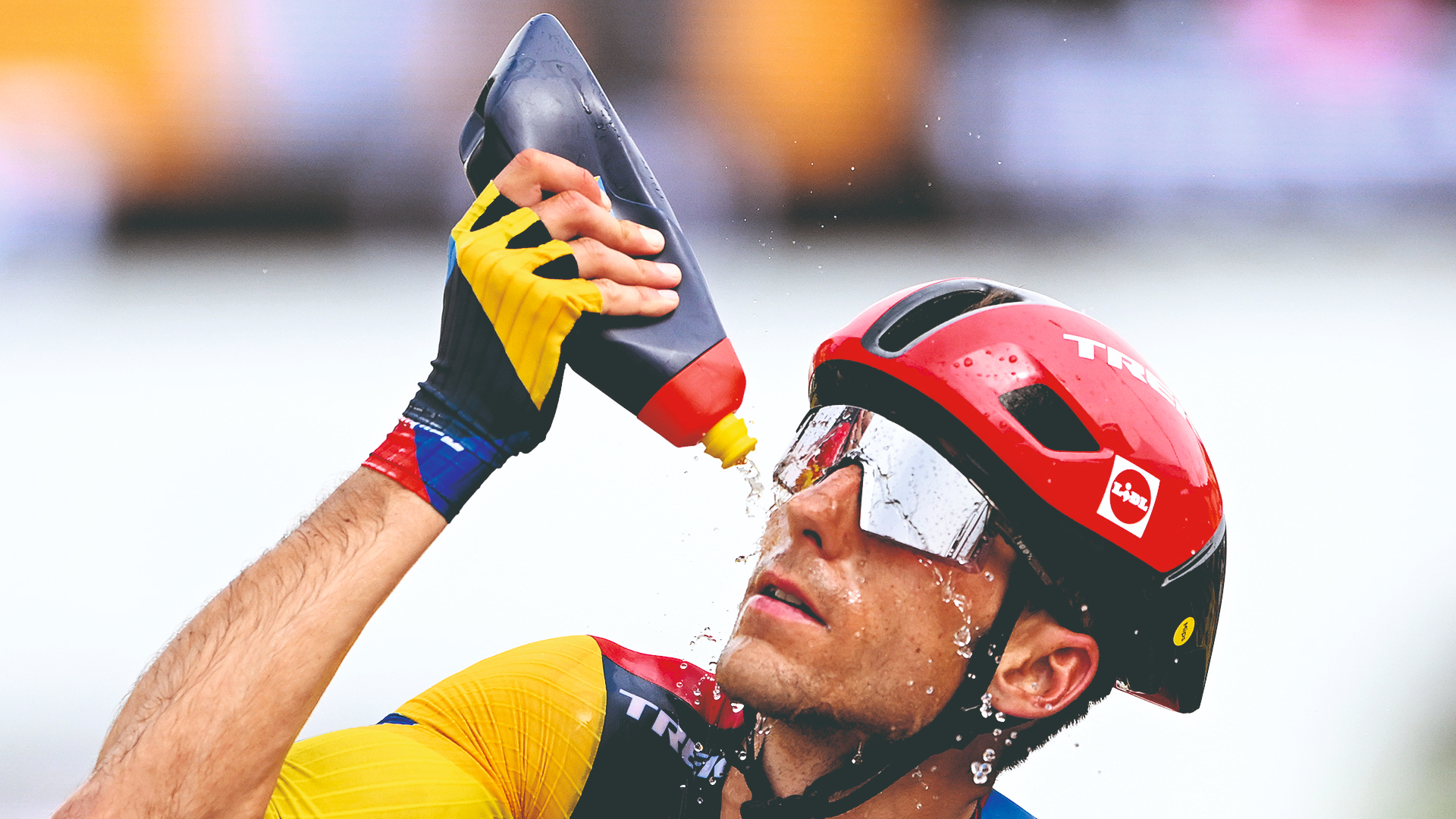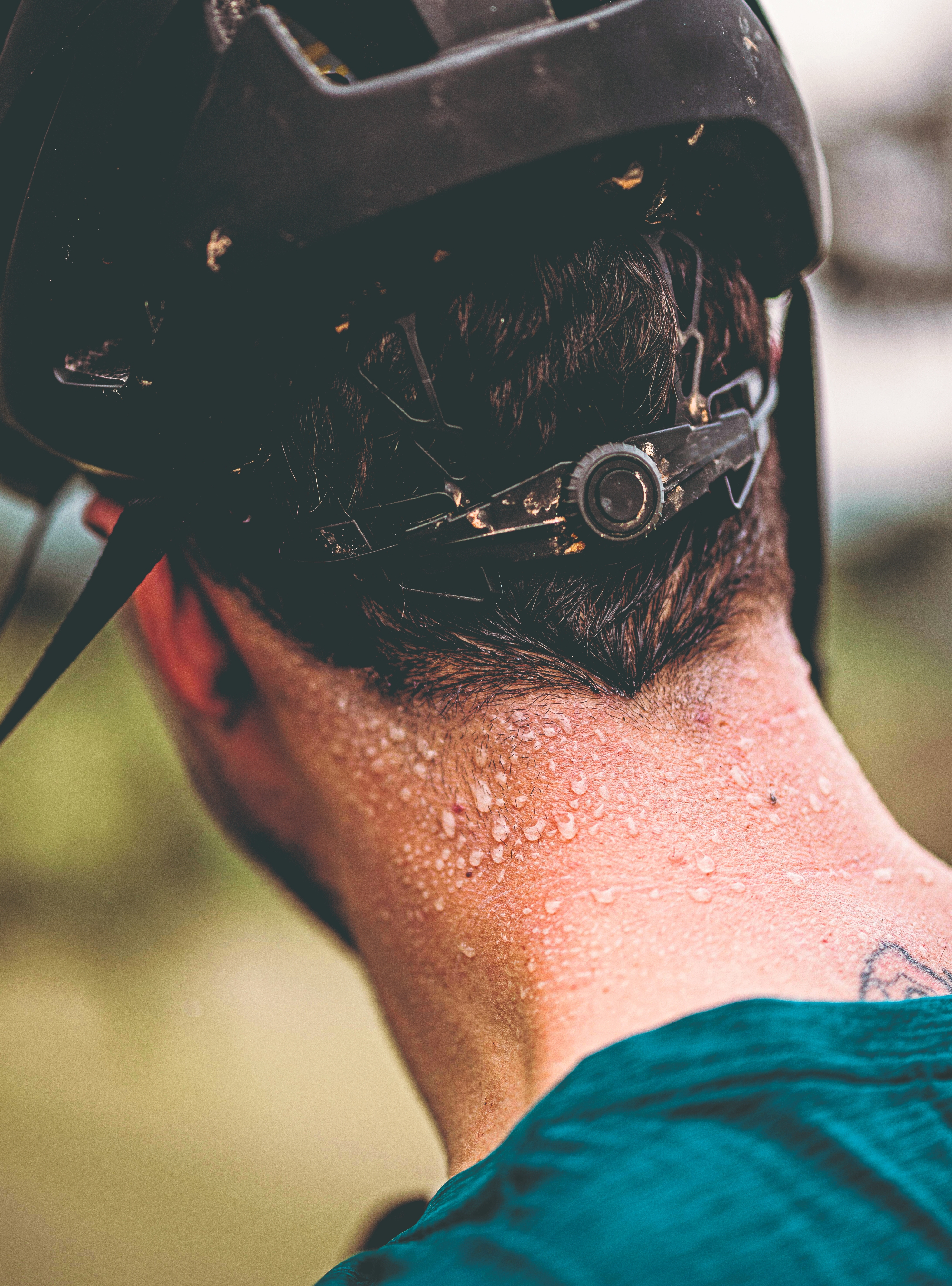I’m a torrential sweater - why do I leak so much, and what does it mean for performance?
Perturbed by his own torrential sweating, Steve Shrubsall goes on a hunt for the truth about how perspiration affects performance at the pedals

Two Wattbike Atoms, two iPhones, three pairs of bone- conducting headphones, a pair of Nissan Qashqai keys and about £50 in cash. No, I haven’t just had a happy half hour in Cash Converters; these are in fact a list of things I have, over the course of the past two years, sweated into oblivion. Yes, perspiration positively gushes from my brow in huge roiling tides. I’ve lost count of the number of times I’ve been asked, “Oh, is it raining outside?” when, no, I’ve merely been for a 30-minute bike ride on an 18oC day. And as for turbo sessions, well, let’s just say that I’m fairly sure I’ve compromised the structural integrity of my garage.
I wanted to get to the bottom of this: why do I leak like I’ve got several washers and a screw or two loose? Am I specially adapted to lose heat, or will I one day be found shrivelled up by the roadside looking like a large prune? Seriously, I wanted to know whether sweating in such ludicrous volumes is detrimental to performance. It means I need to consume more water and, potentially, electrolytes while racing, but is that a disadvantage?
Poring over the data
To get some hard data, I decided to use Flowbio’s new S1 sensor, which measures sweat rate as well as sodium losses. I strapped the device to my arm and hit the lanes for a brisk hour-and-a-half’s ride. Before analysing the data, though, let’s look at the importance of hydration and sweating, a homeostatic pairing on which we as cyclists rely absolutely. “When we were setting out hydration strategies at Team Sky,” says Nigel Mitchell, a former head nutritionist for Britain’s only WorldTour team, “we’d start off with a lot of first-base principles: water is for movement of metabolites, for removing waste from muscles, for the integrity of the cell.”
For cyclists, some of the water we drink needs to end up being secreted onto the surface of the skin to cool us down. “Heat training is very important for athletes about to compete in hot climates,” says Mitchell. “One of the adaptations that we look for is how quickly you start to sweat. As you become heat-adapted, your body dilates the capillaries more easily and faster, dissipating heat more efficiently.”
So maybe the incorrigible deluge from my pores, while fatal to electronic items, is in fact very good for me as a cyclist. Hold on a minute, though: Mitchell said elite riders start sweating sooner, but not that they sweat out fluid at a greater rate. Another concern for me is that I’m sweating out all my reserves of precious sodium – isn’t this a problem? Not necessarily, says Mitchell. “As people become heat- adapted, the concentration of sodium in the sweat reduces. That’s why it’s a good idea to do a sweat test before you’re heat-adapted, then another after.” Planning a hydration strategy during the winter is a schoolboy error, explains Mitchell. “There have been reports of riders finishing the Tour 3kg heavier as a result of water retention from consuming too much salt.”
Sweating is good, then – but even at my apparently extreme rate?
Then again, do I – objectively speaking – sweat an abnormal amount? Let’s see where I stack up on the sweat spectrum. The range is surprisingly wide, I learned from James Hatton from Precision Hydration: while some riders might lose a litre per hour while riding hard, very heavy sweaters can perspire at three times that rate. Hatton cautioned that, at the end of a ride, I should be no more than 2% lighter – otherwise my level of fluid loss may have been detrimental to my performance. For me as an 88kg rider, that means I should aim to lose no more than 1.8kg during a ride – or 1.8 litres of fluid. Weighing yourself before and after a ride is an easy way of keeping track of how well you are hydrating.
The latest race content, interviews, features, reviews and expert buying guides, direct to your inbox!
During a two-and-a-half-hour ride on an 18oC day in May, averaging 20mph over 50 miles – more or less a time trial for me – I lost 2.5 litres of sweat, i.e. one litre per hour, according to Flowbio’s S1. Riding at this intensity on a warmer day would push my sweat rate to over two litres per hour. Is that pro-level sweating, I asked optimistically. According to Hatton – and based on predictive estimates – in extreme heat of 38oC, Tadej Pogačar sweats 2.8 litres per hour. Hatton explained that, in the same conditions, my sweat rate would likely be considerably higher.
“It is at these extreme temperatures that the importance of getting heat acclimated becomes apparent,” he said. “Heat-adapted athletes have lower steady state sweat rates – they sweat more efficiently.”

Sodium loss is no problem during rides of less than four hours
Sodium loss
Professional cyclists have to deal with long days in sweltering conditions as a basic requirement of their job. The Grand Départ of this year’s Tour de France took place in Florence, Italy amid blazing temperatures. Combined with a parcours comprising nearly 4,000 metres of vertical gain, the opening stage called for stringent planning by team doctors and nutritionists. “For our riders, adapting to race in these kinds of temperatures is not only a performance benefit, it’s also important for their health,” says EF Pro Cycling head doctor Jon Greenwell. “The best example is Ben Healy. In a Belgian stage race in his first season, where it was 32-33oC, he really struggled – the first two days were really hard for him and that’s when we worked out that the heat wasn’t very good for him.” After lab tests at Loughborough University, Healy was sent away to undergo the team’s heat acclimation protocol. “We took him back into the laboratory a week later, and then re-measured everything to see what the adaptation was,” continues Greenwell. “The test showed that he was able to acclimate to heat, which helped us individualise the programme for him.”
Does the fact I start dripping straight from the gun mean I’m partially heat-adapted already? The answer, according to my sweat profile, is a resounding no. Based on my 2.5-hour ride mentioned above, each litre of sweat I shed contained 2,342mg (or 2.3g) of sodium. On a subsequent six- hour ride, I lost just under 2g per litre. The average rate of sodium depletion is around 1g per litre – whereas I was losing enough to put paid to the slug population of West Sussex. What were the ramifications for me of losing so much salt?
Asker Jeukendrup, a sports nutrition scientist, was unfazed by my data: “You’re losing 2.3g of sodium per litre of sweat, which is fairly high but by no means alarming. It’s towards the high end of the spectrum but I’ve seen losses of 3.5g per litre.” What proportion of that 2.3g per litre should I be replacing on the bike to maintain optimal performance? “If you’re riding for less than three hours, there’s really no need to replace any of it – just have a meal afterwards, which will probably contain more sodium than you’d lose throughout the ride. You have around 70g of salt in the body to start with.”
Things get a little more complicated with longer rides and events. “At four hours or longer, the total amount [of sodium] you lose actually becomes quite significant,” said Jeukendrup. “Then again, a bigger health risk is drinking too much water, which can in extreme cases make sodium concentration in the body fall dangerously low [hyponatremia].” Sweat is always more dilute (more watery, less salty) than your blood – and no one should aim to drink significantly more water than they’re losing. “Because of sweating, the sodium concentration of the blood rises – provided you don’t over-drink, the chances of sodium levels dropping become slimmer and slimmer.” In very long events, to guard against sodium deficiencies in the longer term, Jeukendrup suggested I consume 0.5-1g per hour.

Sweat rates vary widely between individuals
Sweaty facts
1) It takes about 10 one-hour heat sessions to become fully heat-acclimated.
2) Heat-adapted athletes begin sweating sooner and sweat more efficiently.
3) Sodium losses tend to decrease as a rider becomes heat-acclimated.
4) Aim to finish a ride with no more than a 2% body weight (fluid) loss.
5_ Additional sodium should be consumed with caution; adding too much salt can cause fluid retention and health issues.
Heat acclimation
Given my high sweat rate even on cloudy days with temperatures barely breaching the mid-teens, should I consider heat training? One method is to take a hot bath, at about 40 ̊C, to raise core temperature and help the body adjust to the heat. The theory being that by sweating a lot, the body ‘learns’ to sweat more efficiently. Mitchell outlined the heat acclimation basics.
“It only takes 10 days of cumulative sessions. Start gradually on the turbo in a hot room – about 30oC – just pedalling away at 100-150 watts for about 45 minutes for the first few sessions, then just build them up.”
So how do we know when we’re heat acclimated and how does it benefi t us? “There are signs we can measure in the laboratory, such as lowered resting heart rate, lowered core body temperature, faster onset of sweating, sharper rate of sweating onset, increased blood plasma,” Hatton said. “The most noticeable change, though, is feeling more comfortable during and after exercising in the heat. Secondly, you will feel yourself sweating out of areas like your arms and legs like you’ve never felt before – your sweat coverage is more even.”
Riding bikes is a demanding pastime, and our cooling system plays a pivotal role over the summer. Ascertaining the sort of sweater you are certainly helps put you on the right path to personalising a hydration plan. As for me, my rapid sweat onset rate is a good thing, as during shorter rides it helps to cool me quickly, with little need to replace fl uids or electrolytes on the bike. On longer rides, however, my heavy sweat rate could prove more of a hindrance. I’ve learnt that a dialled-in hydration plan, plus some heat acclimation training, could make an important diff erence – and avoid long summer rides ending with a death march to the nearest train station. Time to run myself a nice hot bath...
Steve has been writing (mainly fitness features) for Cycling Weekly for 11 years. His current riding inclination is to go long on gravel bikes... which melds nicely with a love of carbs